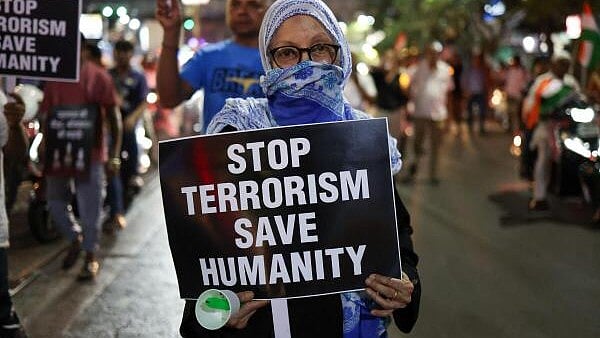
A woman holds a placard and a candle as she takes part in a solidarity walk condemning a suspected militant attack on tourists near south Kashmir's scenic Pahalgam, in Srinagar, in Kolkata.
Credit: Reuters Photo
Srinagar: The Centre’s explanation for the absence of security at the site of Tuesday’s deadly terrorist attack in Pahalgam has sparked widespread skepticism as local officials and tourism stakeholders’ version of events sharply contradict the government’s claims.
At an all-party meeting in New Delhi on Thursday, the Central government reportedly told lawmakers that the Baisaran meadow, where 26 civilians were gunned down, was not officially open to tourists until June. The absence of police and paramilitary presence, they argued, stemmed from this status.
However, a deeper investigation reveals that the Baisaran meadow — often referred to as “Mini Switzerland” — remains open to tourists for most of the year. Local tour operators, pony ride associations, and tourism officials say the area typically remains accessible except during the peak winter months when snowfall blocks access.
“Tourists have been visiting Baisaran every day this season. No police clearance, no special permission has ever been required,” said Sheikh Mohammad Sultan, a senior tour operator and President of the Indian Association of Travel & Tourism Experts, Kashmir chapter. “Almost 70 per cent of visitors to Pahalgam make it a point to see Baisaran.”
Supporting these claims is a signboard at the entrance to Baisaran, installed by the Pahalgam Development Authority, listing an entry fee of ₹35 per person. Officials confirmed that the collection of this fee is outsourced annually through auction, indicating that the site was fully operational and welcoming visitors at the time of the attack.
“Infrastructure has been developed by the department and more projects are in the pipeline for Baisaran tourism. Visiting Baisaran has never required security clearance or police authorisation for tourists,” a tourism official said, wishing anonymity.
Security arrangements, or the lack thereof, are now under intense scrutiny. The dirt track connecting Pahalgam town to Baisaran was completely unguarded. Only four unarmed guards from an auxiliary wing of the Jammu and Kashmir Police were present. The nearest Central Reserve Police Force (CRPF) camp was located almost five kilometers away — a critical gap that may have delayed the response to the carnage.
According to official accounts, the first CRPF responder took nearly an hour to reach the site and send a preliminary report, while additional forces arrived more than one and a half hours after the assault had ended.
Locals like Waheed Ahmad, president of the pony operators’ association in Pahalgam, point out that despite the area’s popularity, no additional security measures were introduced even as tourist traffic picked up in recent weeks.
“We have been taking tourists to Baisaran for decades without any need for police permission, but in today’s environment, one would expect better vigilance,” Ahmad said.
Eyewitness videos and photographs from days before the attack show tourists visiting Baisaran in significant numbers, enjoying pony rides and the spring bloom — a fact that casts further doubt on the Centre’s assertion that the area was “closed” to tourists.
The contradictions have fuelled suspicions that authorities failed to adequately assess the threat level despite prior intelligence warnings about potential attacks targeting the Valley’s nascent tourist season.